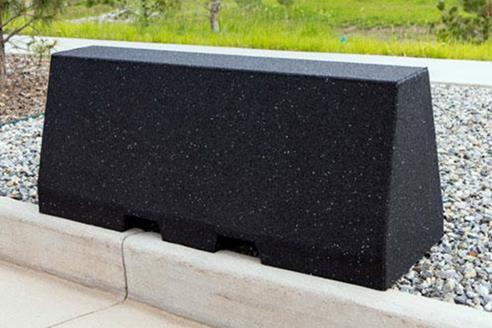
Civil Engineering Team
A leader in the design and implementation of the latest and the most innovative engineering methods


Tire Derived Aggregates (TDA)
Applications - Recycled Rubber Crumb
TDA, or recycled shredded rubber, is one of the most common products obtained from recycled tires. Through crushing and grinding, tires are reduced to small rubber particles known as crumb rubber. Crumb rubber has a wide range of applications across different industries:
Additionally, ASTM D6270 - 08 standard (Reapproved 2012) has approved the use of these materials in building engineering applications and specifies their conditions. The standard outlines applications for TDA, including:


Prefabricated Crumbed Rubberized Concrete Block
These parts are made of CRC concrete with TDA materials, in accordance with ASTM D6270-08 standard. The incorporation of TDA in CRC concrete enhances its mechanical and dynamic properties, such as increased energy absorption, improved deformation, and greater resistance to cracking. Consequently, using this type of concrete in the construction of prefabricated parts offers several advantages:


Next Generation Recycled Composite Material
Performance Advantages

Prefabricated Components Applications
Prefabricated components are widely used for walls, traffic barriers, passageway tables, crossings, and sidewalk paving. These parts come in various sizes, shapes, and colors, and are generally categorized into two main types: prefabricated concrete parts and plastic parts.
Precast concrete parts are utilized in various building and traffic sectors. However, they are less popular due to several drawbacks, including their weight, transportation challenges, installation and relocation difficulties, potential for injury during accidents, and high cost.
Plastic parts, on the other hand, are favored for their light weight, easy portability, lack of need for painting, recyclability, and reasonable price. Despite the high cost of raw materials, large plastic parts for traffic barriers or walls must be made hollow to keep costs manageable. Consequently, these parts need to be filled with water after installation to gain sufficient weight and stability. This requirement to fill and empty them for relocation is one of the main disadvantages of plastic parts.
Next Generation Recycled Composite Material





Tire Derived Aggregates (TDA)
Applications - Recycled Rubber Crumb
TDA, or recycled shredded rubber, is one of the most common products obtained from recycled tires. Through crushing and grinding, tires are reduced to small rubber particles known as crumb rubber. Crumb rubber has a wide range of applications across different industries:
Additionally, ASTM D6270 - 08 standard (Reapproved 2012) has approved the use of these materials in building engineering applications and specifies their conditions. The standard outlines applications for TDA, including:


Tire Derived Aggregates (TDA)
Applications - Recycled Rubber Crumb
TDA, or recycled shredded rubber, is one of the most common products obtained from recycled tires. Through crushing and grinding, tires are reduced to small rubber particles known as crumb rubber. Crumb rubber has a wide range of applications across different industries:
Additionally, ASTM D6270 - 08 standard (Reapproved 2012) has approved the use of these materials in building engineering applications and specifies their conditions. The standard outlines applications for TDA, including:


Prefabricated Crumbed Rubberized Concrete Block
These parts are made of CRC concrete with TDA materials, in accordance with ASTM D6270-08 standard. The incorporation of TDA in CRC concrete enhances its mechanical and dynamic properties, such as increased energy absorption, improved deformation, and greater resistance to cracking. Consequently, using this type of concrete in the construction of prefabricated parts offers several advantages:


Prefabricated Crumbed Rubberized Concrete Block
These parts are made of CRC concrete with TDA materials, in accordance with ASTM D6270-08 standard. The incorporation of TDA in CRC concrete enhances its mechanical and dynamic properties, such as increased energy absorption, improved deformation, and greater resistance to cracking. Consequently, using this type of concrete in the construction of prefabricated parts offers several advantages:


Next Generation Recycled Composite Material
Performance Advantages

Next Generation Recycled Composite Material
Performance Advantages

Prefabricated Components Applications
Prefabricated components are widely used for walls, traffic barriers, passageway tables, crossings, and sidewalk paving. These parts come in various sizes, shapes, and colors, and are generally categorized into two main types: prefabricated concrete parts and plastic parts.
Precast concrete parts are utilized in various building and traffic sectors. However, they are less popular due to several drawbacks, including their weight, transportation challenges, installation and relocation difficulties, potential for injury during accidents, and high cost.
Plastic parts, on the other hand, are favored for their light weight, easy portability, lack of need for painting, recyclability, and reasonable price. Despite the high cost of raw materials, large plastic parts for traffic barriers or walls must be made hollow to keep costs manageable. Consequently, these parts need to be filled with water after installation to gain sufficient weight and stability. This requirement to fill and empty them for relocation is one of the main disadvantages of plastic parts.
Next Generation Recycled Composite Material
Prefabricated Components Applications
Prefabricated components are widely used for walls, traffic barriers, passageway tables, crossings, and sidewalk paving. These parts come in various sizes, shapes, and colors, and are generally categorized into two main types: prefabricated concrete parts and plastic parts.
Precast concrete parts are utilized in various building and traffic sectors. However, they are less popular due to several drawbacks, including their weight, transportation challenges, installation and relocation difficulties, potential for injury during accidents, and high cost.
Plastic parts, on the other hand, are favored for their light weight, easy portability, lack of need for painting, recyclability, and reasonable price. Despite the high cost of raw materials, large plastic parts for traffic barriers or walls must be made hollow to keep costs manageable. Consequently, these parts need to be filled with water after installation to gain sufficient weight and stability. This requirement to fill and empty them for relocation is one of the main disadvantages of plastic parts.
Next Generation Recycled Composite Material